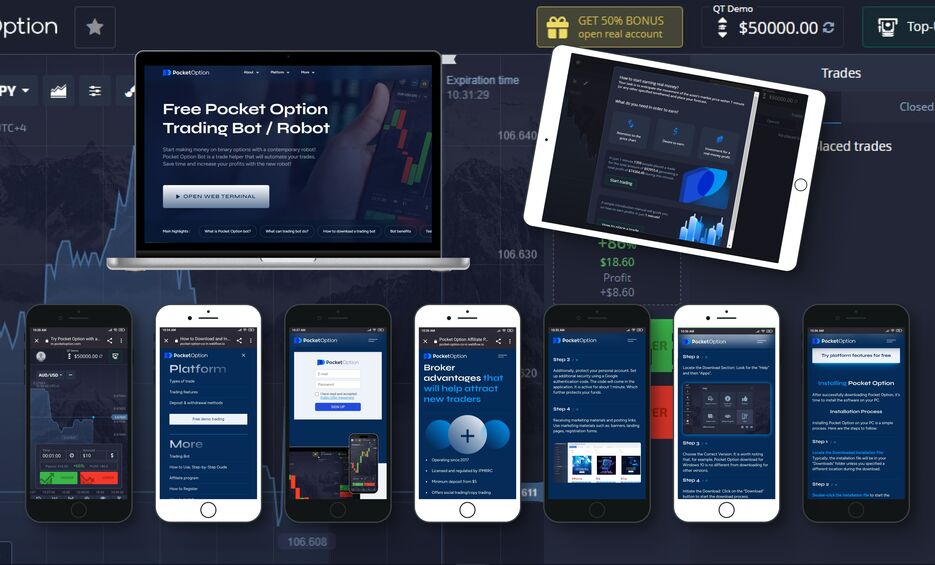
Understanding Pocket Option API with Python
The Pocket Option platform has been gaining popularity among traders for its user-friendly interface and comprehensive trading options. As the trading landscape continues to evolve, so does technology, especially when it comes to automation. The pocket option api python https://pocket-option.co.com/vhod/ offers traders the ability to automate their trading strategies, manage their accounts, and access real-time market data seamlessly.
What is the Pocket Option API?
The Pocket Option API allows developers and traders to interact with the Pocket Option platform programmatically. By using this API, users can execute trades, retrieve account information, and receive real-time market data directly into their applications. This makes it an invaluable tool for those looking to streamline their trading processes, implement custom strategies, and enhance their overall trading performance.
Getting Started with Pocket Option API in Python
To begin using the Pocket Option API with Python, you first need to set up your development environment. Ensure you have Python installed on your machine. You can download it from the official Python website. Once you have that, you will also want to install the `requests` library, which will be used to make HTTP requests to the API.
pip install requestsAuthentication
Before you can start making requests to the Pocket Option API, you need to authenticate your account. This usually involves obtaining an API key from the Pocket Option website. Once you have your key, you can include it in your requests to access your account data.
Example of Authentication
import requests
API_KEY = 'your_api_key'
headers = {
'Authorization': f'Bearer {API_KEY}',
}
response = requests.get('https://api.pocketoption.com/v1/account', headers=headers)
if response.status_code == 200:
print('Authentication successful:', response.json())
else:
print('Authentication failed:', response.status_code, response.text)
Making API Calls
The real power of the Pocket Option API lies in the various calls that you can make. Below are some key API calls that can help you get started:
1. Retrieving Account Information
With the API, you can retrieve essential account information, such as balance and account type.
response = requests.get('https://api.pocketoption.com/v1/account', headers=headers)
if response.status_code == 200:
 account_info = response.json()
print('Account Balance:', account_info['balance'])
else:
print('Error fetching account info:', response.status_code)
account_info = response.json()
print('Account Balance:', account_info['balance'])
else:
print('Error fetching account info:', response.status_code)
2. Executing Trades
Placing a trade is as simple as sending a POST request. Below is an example of how to execute a trade:
trade_data = {
"amount": 10,
"direction": "call", # "call" or "put"
"asset": "EUR/USD",
}
response = requests.post('https://api.pocketoption.com/v1/trade', headers=headers, json=trade_data)
if response.status_code == 200:
print('Trade executed successfully:', response.json())
else:
print('Error executing trade:', response.status_code, response.text)
3. Fetching Market Data
To have a successful trading strategy, it’s crucial to have access to real-time market data. You can fetch market data using the following API call:
response = requests.get('https://api.pocketoption.com/v1/market-data', headers=headers)
if response.status_code == 200:
market_data = response.json()
print('Market Data:', market_data)
else:
print('Error fetching market data:', response.status_code)

Building Your Trading Strategy
Now that you’re able to interact with the Pocket Option API, it’s time to build your trading strategy. An effective strategy often involves technical analysis indicators, proper risk management, and backtesting.
Implementing a Simple Moving Average Strategy
A common strategy among traders involves using simple moving averages (SMA). Below is a basic example of how you can implement an SMA strategy with Python.
import numpy as np
def calculate_sma(prices, window):
if len(prices) < window:
return None
return np.mean(prices[-window:])
# Example price data
prices = [1.1, 1.15, 1.2, 1.25, 1.3, 1.35, 1.4]
sma = calculate_sma(prices, window=3)
print('Current SMA:', sma)
# Based on SMA, decide to trade
if prices[-1] > sma:
# Execute a call trade
print('Executing call trade...')
else:
# Execute a put trade
print('Executing put trade...')
Best Practices When Using Pocket Option API
When interacting with any API, including the Pocket Option API, it’s essential to follow best practices to enhance security and performance:
- Secure your API keys: Avoid exposing your API keys in public repositories.
- Handle errors gracefully: Always check the response status and handle errors accordingly.
- Optimize API calls: Make sure to minimize the number of requests by caching data when possible.
Conclusion
The Pocket Option API paired with Python offers robust tools for automating trading. By leveraging the power of the API, traders can access their accounts, execute trades, and gather essential market data in real-time. Whether you’re a beginner looking to learn or a seasoned trader aiming to optimize your strategies, the Pocket Option API provides all the necessary resources to enhance your trading experience.
For further exploration, don’t hesitate to delve deeper into the official documentation and start implementing your strategies today!